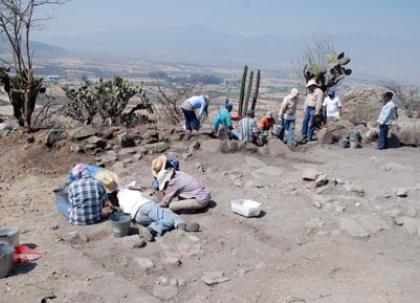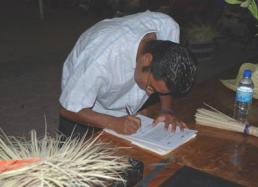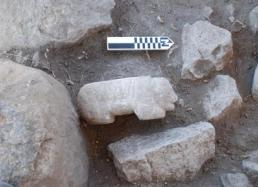4: Place of the Dead and Museums for the Living
Mitla is known as “the place of the dead,” and so far after several weeks in the field excavating, its indigenous name seems pretty apt to us. We selected a terrace to excavate on the south slope of the Mitla Fortress that seemed to have a significant amount of accumulated sediment (so more opportunity to find intact deposits) and to be reasonably free of vegetation.
At this point, we really don't know how typical this terrace (Terrace 56 on our 1998 map) is of the rest of the site. But, we've been surprised to find six burial contexts (and eight individuals) already in a relatively short time (see above photo.) All of these burials cut into earlier surfaces and seem to have been positioned late in the prehispanic history of this terrace.
Our working hypothesis is that parts of the Mitla Fortress may have remained occupied (perhaps areas closer to the top of the hill) even after the specific terrace that we're excavating no longer served a residential use, although addressing this issue likely will have to await subsequent seasons of study, focused upslope.
Based on accompanying grave goods, these six burial contexts appear to pertain to later in Monte Albán V or the Postclassic, a long period that has generally been dated between A.D. 900 - 1520. Never in ten seasons at El Palmillo (in neighboring Santiago Matatlán) did we find so many burials that date to the final use of a terrace. And only rarely did we have this many burials associated with a single surface, so we already have a number of interesting questions to ponder
But we expect differences, since not only is the Mitla Fortress a different site than El Palmillo, but the Fortress burials date considerably later in time than the final occupation at El Palmillo, which mostly (except for the basal slopes) was abandoned as a residential location by A.D. 900.
Another striking difference that we're finding at the Mitla Fortress is the quantity of obsidian (volcanic glass) that we're recovering, especially green obsidian. Not only does it seem that we're finding more pieces than we collected at El Palmillo or even during our earlier study in Ejutla, but we're also noting larger pieces.
The recovery of large amounts of obsidian is in one sense not surprising, since when we mapped the site in 1988, we noted the abundance of this much valued material that could yield sharp cutting edges. But it's fascinating when you compute that there's no known obsidian source in the entire State of Oaxaca, and that the green obsidian almost certainly arrived through a lengthy exchange from the area of Pachuca, Hidalgo, a place that required more than a half days drive by car, over many mountains!
Although we're immensely enjoying our time at the Fortress, trying to piece together new sets of clues, getting to know a new crew, appreciating a somewhat less strenuous and shorter daily hike than we had at El Palmillo, we certainly continue to have El Palmillo and the people of Santiago Matatlán in our hearts and minds.
A few weeks back, we attended an evening event there—one where the Mexican Institute of Anthropology and History (INAH) officially handed over our research collections (from ten years of investigation) to the Museum Committee and municipal authorities of the town, so that these collections might serve as the basis for a community museum. Linda and I were named witnesses and signers of a governmental document that implemented this handoff, the last official step that the community was required to pass prior to the establishment of a community museum (see Photo #1 below.)
What we didn't realize was that this was the first time that a full research collection from long-term scientific excavations was entrusted to a local community for official safeguarding and permanent storage (as an auxiliary of the Institute of Anthropology and History). The document (or acta) was read and signed in the town square of Santiago Matatlán in front of a local crowd of several hundred people and was attended by officials from Mexico City, Oaxaca City, and even Chile (the president of a global organization of community museums).
As this process moves closer to the home stretch for Santiago Matatlán, we've also been speaking with the governmental authorities in Mitla, who are preliminarily interested in going through a similar process.
Words of the Day: museo, which means “museum” and acta, which means “an act,” or official governmental proclamation or document.
More soon,
Gary




